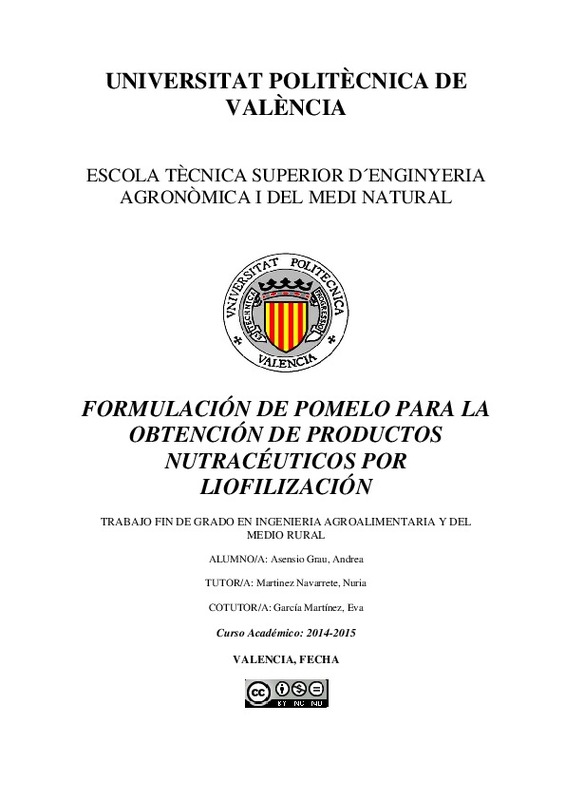|
Resumen:
|
[ES] Las frutas presentan elevados contenidos en compuestos bioactivos, como vitaminas, minerales, compuestos fenólicos, fibra, etc. Está comprobado que estas sustancias juegan un papel esencial en la prevención de ciertas ...[+]
[ES] Las frutas presentan elevados contenidos en compuestos bioactivos, como vitaminas, minerales, compuestos fenólicos, fibra, etc. Está comprobado que estas sustancias juegan un papel esencial en la prevención de ciertas enfermedades relacionadas con el daño oxidativo. No obstante, las frutas son un recurso marcado por la estacionalidad de su cultivo y con una escasa vida útil, asociado a su alto contenido en agua, lo cual limita su disponibilidad. En este sentido, podría ser de gran interés diseñar un producto nutracéutico a base de extractos de fruta. Para ello partir de fruta en polvo obtenida por liofilización podría ser una buena estrategia. Sin embargo, los productos en polvo presentan problemas de apelmazamiento que es necesario contrarrestar. Una técnica habitual para su estabilización es la incorporación de solutos de alto peso molecular. Por otra parte, la liofilización es un proceso caro que requiere, entre otras cosas, un largo tiempo de proceso. La eliminación parcial de agua antes de la liofilización podría ayudar a disminuir costes. En este estudio se pretende comparar la calidad funcional del pomelo en polvo obtenido por liofilización sin ningún pretratamiento con la del obtenido a partir de muestras a las que se ha incorporado goma arábiga y fibra de bambú y que se han predeshidratado parcialmente por microondas. A las dos muestras de pomelo liofilizado se les extraerá y cuantificará la Vitamina C, fenoles totales y carotenoides totales. Se analizará la capacidad antioxidante de los extractos. Los resultados permitirán conocer la viabilidad del pomelo de cara al uso como nutracéutico para prevenir la aparición de daño oxidativo celular y la idoneidad del pretratamiento de las muestras.
[-]
[EN] : Fruits have high contents of bioactive compounds such as vitamins, minerals,
phenolic and terpene compounds, fiber etc. It is proven that these substances play an
essencial role preventing certain oxidative damage ...[+]
[EN] : Fruits have high contents of bioactive compounds such as vitamins, minerals,
phenolic and terpene compounds, fiber etc. It is proven that these substances play an
essencial role preventing certain oxidative damage related diseases. Nevertheless, fruits
are a resource marked by the seasonal nature of its cultivation and for its limited useful
life. All this is associated with its high water content which restricts their availability. In this
sense, it might be of interest to design a nutraceutical product based on fruit extracts. To do
this, fruit powder obtained by freeze‐drying could be a good strategy. However, powders
present problems of caking which is necessary to counteract. A common tecnique for
stabilization is the addition of high molecular weight solute. Moreover, freeze‐drying is an
expensive process which requires, among other things, a long processing time. The partial
removal of water prior to freeze‐drying may help to reduce costs. In this study the effect of
freeze‐drying on the functional quality of the grapefruit powder samples obtained by freeze‐
drying, without any previous treatment, are compared to the samples which have been
incorporated gum arabic and bamboo fiber pre‐dehydrated by microwave. The four
grapefruit samples were extracted and quantified by different procedures regarding its
compound, vitamin C, total phenols and total carotenoids. In addition, the three extracts have
been analyzed in their antioxidant capacity by three different methods: ABTS, DPPH and FRAP.
The highest antioxidant activity was found in the total phenols extract, obtained by a methanol
solution and water. This result could be considered the best extraction solvent for obtaining a
high antioxidant capacity extract. The results obtained also reveal a loss of antioxidant activity
associated with freeze‐drying without pretreatment. In spite of that, according the reviewed
bibliography, freeze‐drying is the dehydration treatment which supposes smaller losses of
volatile or thermosensitive compounds, in comparison to other processes such as osmotic
dehydration or conventional drying. As for the method of analysis of the antioxidant activity,
DPPH works best for vitamin C and phenols and ABTS has better results for phenols and
carotenoids.
[-]
|







